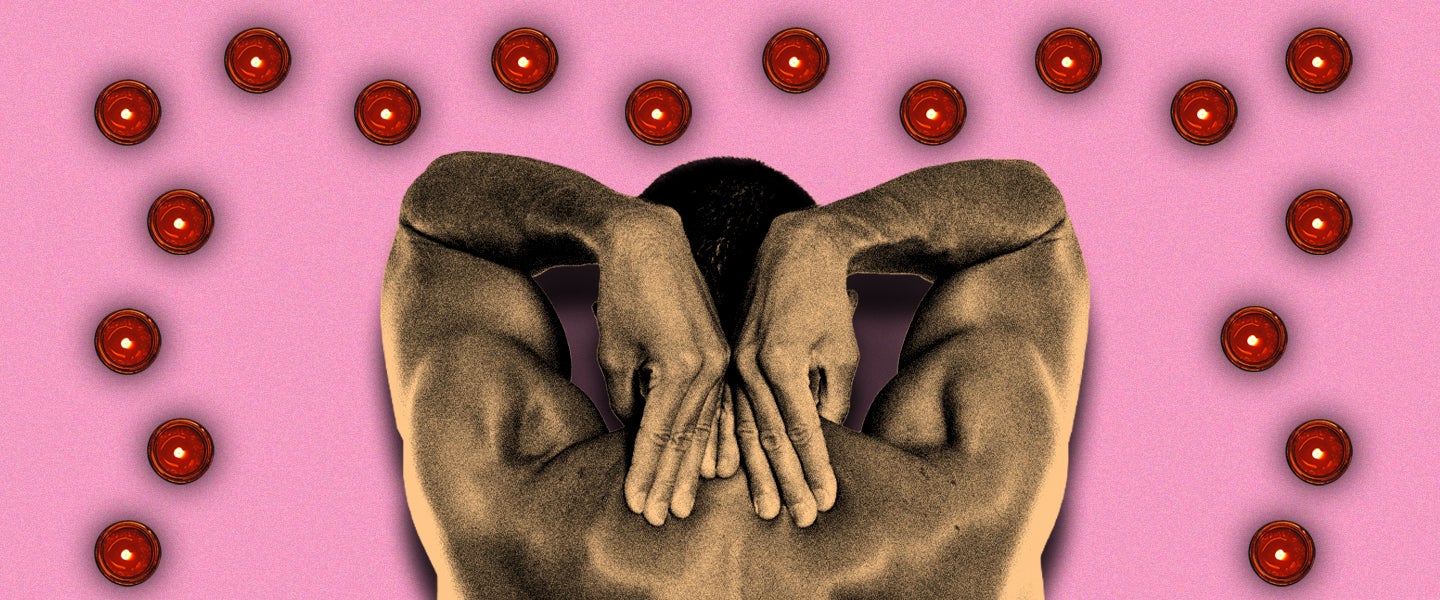Your current definition of “self-massage” probably just refers to compulsive masturbation, and maybe, if you’re feeling really energetic, some half-hearted foam-rolling.
Which is fair enough!
Trying to recreate the spa experience of having another person, trained in the art of massage, working on parts of your back that you can’t even reach is almost pathetic to try alone. But that doesn’t mean you have to give it up entirely: There are techniques to giving yourself a massage that not only work out whatever kinks your neck has developed from hunching over your laptop on your couch all day, but are even somewhat relaxing.
According to Kiera Nagle, a certified pediatric massage therapist and the Director of Massage Programs at Pacific College of Health and Science, the most powerful component of self-massage is simply taking the time to do it. “Some might want to take just five to ten minutes for a spot treatment on tense areas, and that’s fine if it fits your schedule, but people would see a greater effect if they took 20 to 30 minutes and maybe prepare themselves and their space by lighting a candle, to help our nervous system prepare to relax for the massage,” she explains.
The more we can recreate a traditional spa experience, rather than, say, mindlessly watching TV while lazily rubbing our own shoulders, the more effective it will be.
“Part of what we like when we exchange with another person is feeling cared for, and there’s a whole chemical process there with the release of oxytocin, the feel-good hormone,” she says. “When we’re giving ourselves over to another person, that happens more easily. But when we’re applying massage to ourselves, that still happens, just not in the same way. Applying pressure or touch tells our brain that it’s okay to relax. Anything we can do right now away from a screen, focusing on our bodies and having a sensory experience, is going to be a positive thing. It can make us more aware of our postural issues and where our tension is, and being aware is the first step to treating them.”
In terms of specific massage techniques you can apply to yourself, Nagle has a few recommendations. “Start by taking a few deep breaths to switch gears from everything else you’re doing, maybe placing a hand on your heart and your belly just to set your intention,” she says. “From there, an easy move is to take your right hand to your left shoulder or left hand to right shoulder and make a grip between your thumb and forefinger on the muscle between your neck and shoulder, called the trapezius. This big muscle is a muscle that holds a lot of tension. You can make a grip and gather the muscle, pushing your forefinger and your thumb together with the muscle in between. You can also try placing your hand into a fist, placing it on the trapezius and dragging it along the muscle as you turn your head to the side.”
“If we’re getting anxious, we might do a lot of chest breathing,” which can produce tension and tightness in our pectoral muscles, says Nagle. A technique to relieve this is to essentially place your thumbs between your arm and your chest, and then drag your fingers along your pectoral muscles, utilizing the same thumb-to-forefinger technique as you would on your shoulders.
Massage tools or certain household objects can be useful in self-massage, especially for those of us who are skeptical about our own ability to give ourselves a massage. However, Nagle suggests starting with your hands, first. “It’s great to explore with tools, but we have sensory receptors in our fingers and hands,” she says. “With tools, we can be overzealous and apply too much pressure and end up feeling sore. So maybe start with your hands before you begin exploring with tools. This can help you figure out which muscles are really tight, and help warm them up before using tools that would apply more pressure.”
If you do want to utilize tools, though, there are plenty of things you probably already have around your house that will work. “One thing almost everyone should have is a towel. You can do hydrotherapy, soaking the towel in hot water. This will add a nice temperature component. But if you’re just doing a quick break, you can use a dry towel. Hook the towel behind your neck and pull gently side to side or pull up to lengthen the neck,” says Nagle.
“If you have a tennis ball or other handball, you can use that pretty much anywhere. You can roll it over any muscle — your forearm is a good spot. Another great spot for it is the glutes, rolling it over the glutes or sitting on the ball on each cheek. Stones are another tool people can use, and going outside and finding stones to use can be another self-care activity. Even an eraser could work — something that’s hard but has a soft surface.”
Smaller objects like stones or erasers are useful for pressure points on the face or hands, particularly the space between our eyebrows or the skin between our thumb and forefinger.
All this might not totally compare to the hour-long massage you might normally pay someone else for, but that’s okay. Even if you don’t completely fix your body pains, taking 20 minutes away from your computer is worth it by itself.

